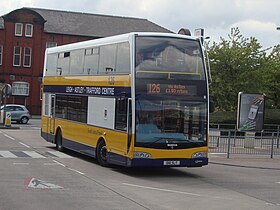East Lancs Olympus
| East Lancs/Optare Olympus | |
|---|---|

A Scania N230UD Optare Olympus owned by South Lancs Travel in Leigh, Greater Manchester
|
|
| Overview | |
| Manufacturer | Optare |
| Production | 2006–2011 |
| Body and chassis | |
| Doors | 1 door or 2 doors |
| Floor type | Low floor |
| Powertrain | |
| Capacity | 68 - 100 seated |
| Dimensions | |
| Length | 10.2m to 11.9m |
| Width | 2,535mm |
| Height | 4.2 to 4.3m |
| Chronology | |
| Predecessor |
East Lancs Myllennium Lolyne East Lancs Myllennium Lowlander East Lancs Myllennium Nordic East Lancs Myllennium Vyking Scania OmniDekka |
| Successor | Optare MetroDecker |
The Optare Olympus (introduced in 2006 as the East Lancs Olympus, and sold as the Darwen Olympus between 2007 and 2008) is a double-decker bus built by Optare. It could be built as a body available on Alexander Dennis Enviro400, Volvo B9TL or Scania N230UD/N270UD chassis with the 2-axle and 3-axle variants.
It is the double-decker equivalent of the Optare Esteem. Some 3-axle Olympus buses were built. A single prototype integral Olympus, designated the Olympus O1030, was built; this later became the basis for the new Optare MetroDecker.
The Olympus was launched by East Lancashire Coachbuilders in November 2006. The first example, built on a Volvo B9TL chassis for Delaine Buses, was displayed at Euro Bus Expo 2006. It had been the intention to exhibit a higher specification model for Ham's of Flimwell, but this was not ready in time for the show, meaning the bus didn't show its full potential.
The Olympus replaced the OmniDekka on Scania chassis, which is 10.6 or 11.9 metres in length. On Volvo chassis, it replaced the Myllennium Vyking. On Alexander Dennis chassis, it replaced the Myllennium Lolyne.
At the beginning of January 2007, Reading Buses ordered six Olympus with Scania chassis for their Loddon Bridge FastTrack park and ride contract to replace Optare Excels. They entered service in a yellow and blue livery in July 2007.
In London, some bus operators purchased Olympus with Scania chassis. Transdev London and Metroline have these buses operating on routes 148, 7 and 297 respectively. Due to problems with the new Transport for London specified air-conditioning units, some buses failed the tilt test by one degree, and entered service late.
...
Wikipedia
